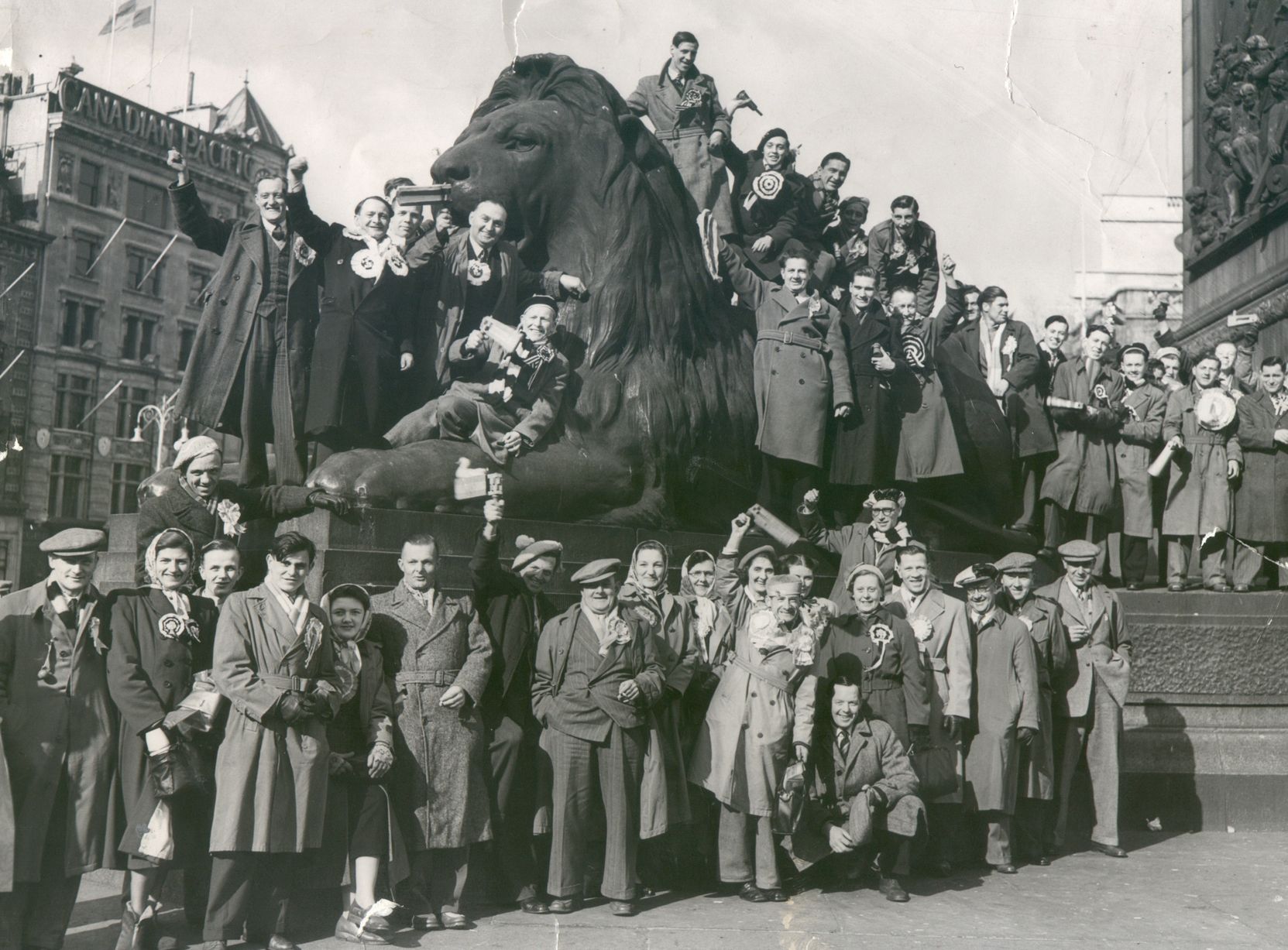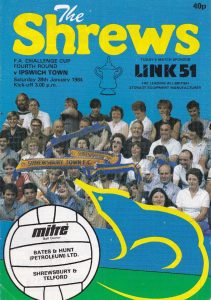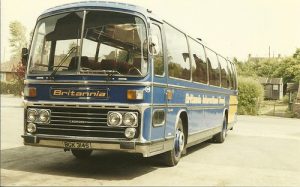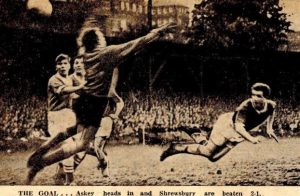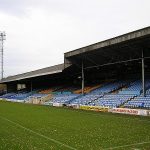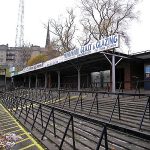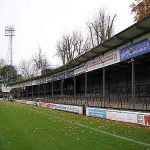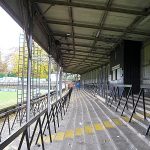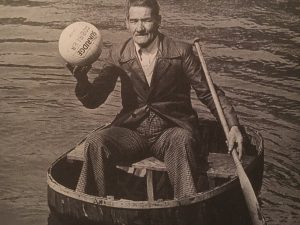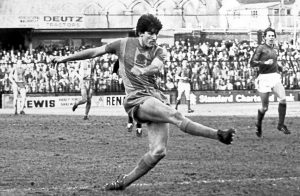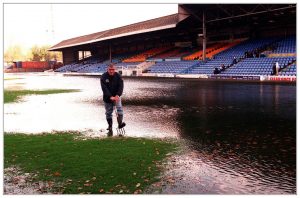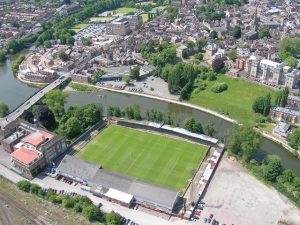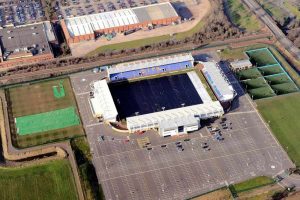Shrewsbury Town 2 Ipswich Town 0
FA Cup 4th Round
28 January 1984
The context
I managed to get to two 4th Round matches this year, Derby v Telford at the Baseball Ground and Shrewsbury v Ipswich at Gay Meadow. This was a greater achievement than it would be now, as in those days all ties were played at the same time and on the same day. Both programmes have identical syndicated content, produced by Centrespot – on this occasion treating readers to features on Nigel Spink, an advert for the Social Democrats and the highly surprising news that a United Kingdom football team wasn’t expected any time soon.
The reason was that Telford’s game was called off so we went to Shrewsbury instead. This scenario used to be common when you could pay on the gate, but the inevitable consequence of rogue fans turning up as “neutrals” (especially on Cup days with large and disorderly away supports on the move) was a punch up between three sets of supporters rather than the traditional two. On this cold Saturday my mates and I were actually on one of Gerald Smith’s Britannia coaches heading for Derby, when the news came through (via a passing car driver) that snowy conditions in the East Midlands had put paid to the match. So back home we went, where some hasty phoning around sorted out a last minute lift to watch a team many Telford fans considered to be deadly rivals.
Gay Meadow
Shrewsbury came to national prominence in the Seventies – due to double promotions which saw them go from the Fourth to the Second Division in just four years, and also via a shock FA Cup win over Manchester City in 1979. At this time their home for 75 years was little altered since 1966, when another Cup run – culminating in a 5th Round defeat to Chelsea – had enabled them to put up a terrace cover next to the ground’s only seated stand.
The main changes to Gay Meadow during Salop’s years in the Second Division were to this stand, and reflected the club’s need for more seats. First its paddock was converted, and then the terraced section to one side also had seats added. The result was a single tidy tier along the length of one touchline, although the former standing area jarred somewhat due to its higher, flatter and plainer roof. The improvements also led to a rather confusing situation where one stand was called by three different names – the Centre Stand, Station Stand, and the other bit.
The rest of the Meadow remained virtually unchanged between 1939, when the Riverside terrace was roofed, and the ground’s closure in 2007. To the left of the stand as you sat in it was the Wakeman End, named for the school behind (and known by old-timers as the Tech End, because until the 60s the school was the town’s technical college). This was a simple, narrow terrace with the home turnstiles in its near corner and a magnificent old-fashioned scoreboard in the other, the sort where a man would emerge at half-time and hang the latest scores on hooks underneath coded letters – making those with programmes both popular and also, if they were visiting fans trying to blend in, uncomfortable.
One consequence of the ground’s cramped position on the banks of the Severn was that anyone who wanted to watch from the Riverside had first to walk across the Wakeman and negotiate a very narrow corner under the scoreboard. This was also the site of some highly unpleasant toilets, in which I once missed the opening goal of a 4-1 victory over Grimsby. Opposite the Wakeman was the Station End, where visiting supporters stood – there was a decent car-park behind its shed-like cover, and police would sometimes walk fans along a path by the railway tracks and straight onto their trains via a disused platform of the nearby station.
- stands
- shed
- hardcore
- pies
(pictures: Stephan Hoogerwaard)
The Riverside, much beloved of the Shrews hardcore, ran the length of one touchline. It was straight at the front, and curved at the back where it followed the line of the river bank. The corrugated-iron roof tracked the same curve and as a result only the corner sections were fully covered. It was hard to get a decent view from anywhere in the Riverside because of the pillars along the front that held the whole thing up, especially as the prison-like 80s perimeter fences always managed to be at eye level no matter where you were. But it was dry and accoustic, and it had a pie hut built into the rear wall at the centre. Fans who stood here could see down the tunnel and be the first to applaud the players coming out.
Gay Meadow is usually remembered as “picturesque”, an over-used term if ever there was one. I think what people mean by this is that it was in a nice place, and superficially it was. It could be pretty in early or late season, when the trees on the river bank and below the prison were in leaf, the stroll over English Bridge was warm and the Severn sparkled. But it was also epically hemmed in, squeezed between the school, the river and a looming railway embankment which meant only one way in and one way out – and not a nice way if Leeds or Newcastle were in town. (The embankment wall was covered in graffiti, including a warning from the ‘Shrewsbury scull-crushers’. Someone had corrected the spelling. That kind of summed the town up.)
The Meadow’s most enduring legend was that of the coracle in which Fred Davies – not to be confused with the Town manager of the same name – would sit during matches, waiting to retrieve any stray footballs that landed in the river (or were deliberately shanked into it by Fourth Dvision centre-backs). Fred was a craftsman who made his own coracles, and at the time of this game he was still just about active. His coracle wasn’t used during the match, however, as I remember seeing it propped up in the Riverside’s empty right hand corner.
The match
This was a fixture with history. In 1981 Salop had drawn 0-0 with Ipswich at the Meadow before losing the replay 3-0. Twelve months later, at a time when Ipswich were top of Division One, Bobby Robson brought his star-studded team here for a 5th round tie and left on the receiving end of a shock 2-1 defeat. Today’s game was therefore eagerly anticipated, and the highlights – including Gary Hackett’s superb opener – were captured by the Match of the Day cameras.
The ground was crowded. Shrewsbury’s notional capacity was 16,000, and with over 13,000 inside and the away end and the seats nowhere near full, we were tightly packed on the far from spacious home terraces. It was cold and gritty. The atmosphere felt uneasy. A little group of school-age skinheads in front of us on the Wakeman were smoking cigar butts, watching the turnstiles alertly in that preoccupied way spotters used to have. We’d been there about thirty seconds when the first Telford fans were outed behind us, and a fist whistled past my face and laid out the man stood next to me. It was the opening scene of a lively afternoon.
Telford’s travelling support to Derby had been around 5000, and maybe 500 of those wound up at the Meadow. For the first half-hour there was fighting everywhere – in the stand, in the Ipswich end, in the Riverside. Within minutes of police breaking up one scuffle, another surfaced somewhere else. Eventually, and not without a lot of pushing, shoving and general recrimination, most of the invaders were rounded up and put into the caged no-man’s land next to the away end. Here a truce formed with the Ipswich fans and a bizarre tripartheid sing- and missile-off ensued, culminating in both groups sarcastically proclaiming “We all agree, Telford are harder than Shrewsbury”.
This is the BBC’s footage. We’re somewhere in the middle of the post-goal surge just to the left of the near post, level with the top of the fence.
Match of the Day 28/1/1984
Match of the Day episode broadcast on 28th January 1984, featuring highlights of FA Cup fourth round ties played that day between Shrewsbury Town and Ipswich Town, Tottenham Hotspur and Norwich City, and Portsmouth and Southampton. Also includes the contenders for Goal of the Month.
We were watching a Shrewsbury team pretty much at its peak. Graham Turner’s side had been promoted into the second tier in 1978, and proceeded to punch above their weight for the next decade. Cup quarter-finalists in 1980 and 1982, they finished 9th in 1983 and would be 8th both this season and in 1985, a remarkable achievement for a club who even in the Second Division often attracted gates of only 3000. But the writing was already on the wall. Many of these players would be tempted away over the next few seasons – MacLaren to Derby, Hackett and McNally to West Brom, Robinson to Birmingham, Pearson to Sheffield Wednesday – while Turner himself was poached by Villa the following summer and eventually ended up at Wolves.
Telford, meanwhile, played their rearranged game four days later and lost 3-2. No Shrewsbury fans were present.
The New Meadow
For all its real or imagined quaintness, the Popplewell Report was bad news for Gay Meadow. Because of the restricted access to both ground and terraces caused by its riverbank location, 5000 was chopped off an already small capacity. A five figure crowd would never be allowed again. It was all a far cry from the days when almost 20,000 could be crammed inside.
Another factor made the ground unsustainable in the long run – the river itself. The Severn encloses the centre of Shrewsbury like a noose, and the outer bank on this part of the loop is low-lying and vulnerable to flooding. Over the years the pitch had been under water more times than anybody cared to remember (the club offices were even built on stilts as a result). This flood risk made it awkward to install the kind of corporate and other facilities increasingly considered necessary for smaller clubs to remain solvent.
As Simon Inglis commented, “one of the ground’s appealing qualities has also been one of its major drawbacks”. This was also true of efforts to sell it, which fell foul of a troublesome covenant to use the land only for sporting purposes (and the not unreasonable quibble that anything else built there would also spend half its time submerged). So the process of moving to the inevitable purpose-built out of town site was protracted, not least because many residents near the preferred location – a field off the A5 – turned out to be the very worst kind of serial objectors, nimby-esque middle-Englanders who regarded having a football ground on their doorstep as the suburban equivalent of opening a gate to the barbarians and inviting them in for scones.
When the New Meadow did finally open, most commentators were distinctly underwhelmed. In an era of bland, badly-connected new-builds, this is arguably the worst – four stands with nothing much to distinguish between them, open, draughty corners, a capacity not much greater than the old place in its final days and a surrounding area almost totally lacking any sort of eating and drinking facilities. To add insult to injury, a ground almost exclusively accessible by road has very few places you can actually leave your car.
But at least it’s dry.
Teams:
Shrewsbury: Ogrizovic, Williams, Cross, MacLaren, Pearson, Griffin, McNally, Petts, Stevens, Brown, Hackett. Sub: Robinson.
Ipswich: Cooper, Burley, McCall, Parkin, Osman, Butcher, Wark, Kinsella, D’Avray, Gates, O’Callaghan. Sub: Gernon.
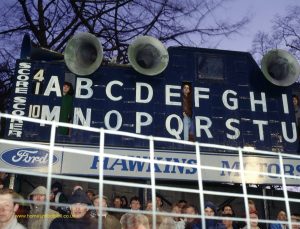
Stuart Roy Clarke
